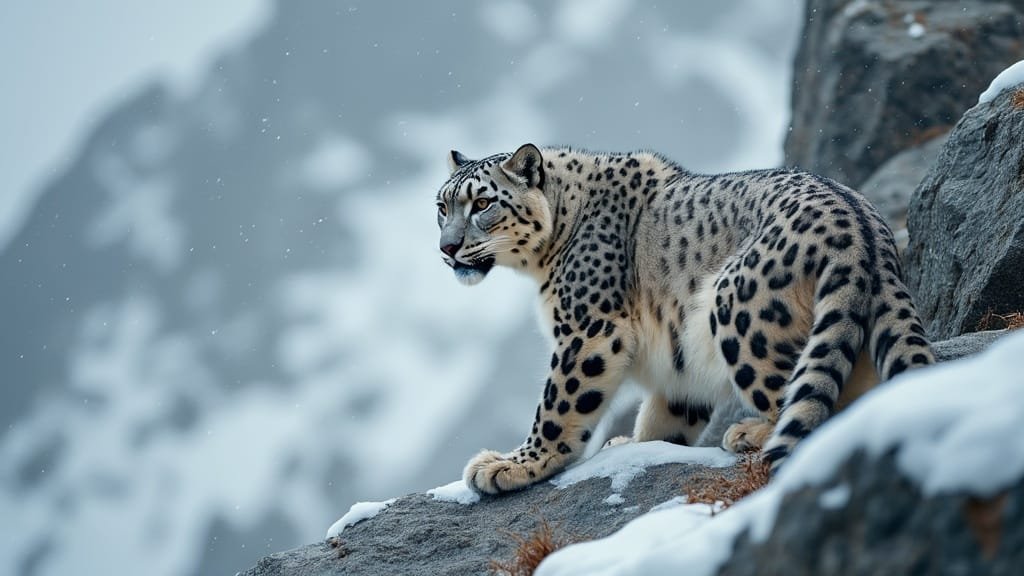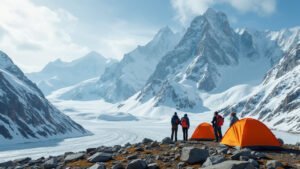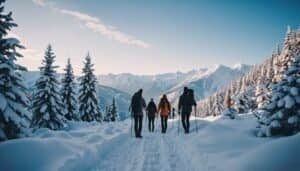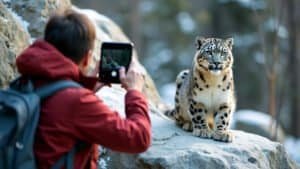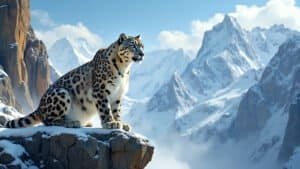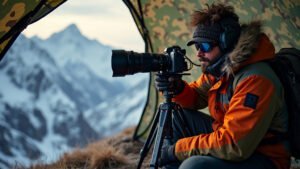Introduction
Photographing snow leopards, elusive and endangered apex predators, requires a delicate balance between capturing their beauty and respecting their welfare. As wildlife photographers aim to highlight the importance of these majestic creatures, ethical considerations must guide every step, ensuring minimal impact on their behavior and habitats
This article explores critical topics, such as understanding the impact of human presence, using responsible techniques, and avoiding harmful practices like baiting or location disclosure
We will also discuss best practices for ethical photography, including contributing to conservation efforts and adhering to guidelines that protect both the snow leopards and their fragile ecosystems
Ethical Considerations for Photographing Snow Leopards
Photographing snow leopards requires careful planning and adherence to ethical standards to ensure these endangered species are not harmed in the process. As snow leopards are highly elusive and live in fragile ecosystems, photographers must recognize their role in wildlife conservation
This section explores how photography can impact snow leopard behavior, techniques to minimize disturbance, and the responsible use of equipment to capture these animals ethically
Understanding the Impact of Photography on Snow Leopard Behavior
Snow leopards (Panthera uncia) are known for their shy, solitary nature and preference for remote, high-altitude environments across Central and South Asia. Human activity, including photography, can cause behavioral disruptions that may compromise their survival
According to Schaller (1998), increased human presence can lead to stress, forcing snow leopards to alter their natural behavior, such as abandoning key hunting grounds, avoiding water sources, or leaving cubs unprotected. This disruption is particularly harmful during the winter months, when food scarcity already challenges their survival
A study published in the Journal of Wildlife Management (2015) highlights that repeated visits by photographers to specific locations can habituate snow leopards to humans, making them vulnerable to poaching or accidental exposure
Habituation occurs when animals become desensitized to human presence, increasing their risk of encounters with illegal hunters or conflicts with livestock owners
Photographers should also avoid inadvertently “chasing” snow leopards by tracking or disturbing them
Research conducted by the Snow Leopard Trust warns that intrusive attempts to follow or photograph the animal can drive them to expend unnecessary energy, leading to exhaustion, particularly in harsh winter environments. Disturbances that force snow leopards to flee can interrupt their feeding or mating behaviors, ultimately reducing their chances of survival
To avoid such issues, wildlife photographers must adopt a “leave no trace” approach by remaining unseen and minimizing their presence. This includes staying far enough away using telephoto lenses, which allow photographers to capture detailed shots without disturbing the animals
Minimizing Disturbance Through Ethical Practices
Ethical wildlife photography begins with a clear understanding of the subject and its habitat. For snow leopards, which inhabit rugged, snowy terrains at altitudes between 10,000 and 15,000 feet, disturbing the ecosystem can have severe consequences for the species and their prey
A common ethical issue is the use of baiting, where food is placed to attract the snow leopard for easier photography
This practice is widely condemned by conservation organizations like the International Union for Conservation of Nature (IUCN) because it can alter natural behavior, create dependency on human-provided food, and attract predators to human settlements. A 2020 IUCN Report emphasized that baiting disrupts ecological balance and can expose snow leopards to harmful interactions with humans
Instead of baiting or artificial setups, photographers should prioritize patience and observational techniques. Utilizing camera traps is an effective and minimally invasive way to photograph snow leopards. Camera traps, when set responsibly, capture images without the need for human proximity
However, even camera traps come with ethical considerations. According to Smith and McCarthy (2019), excessive use of traps in small territories can disrupt wildlife corridors or increase stress among snow leopards. Proper placement, informed by collaboration with conservationists, ensures minimal interference
In addition, photographers should avoid drawing attention to snow leopard locations. Posting exact geographic coordinates on social media or photo-sharing platforms can inadvertently alert poachers
Research published in the Wildlife Society Bulletin (2021) found a direct link between shared location data and increased poaching incidents. To protect snow leopards, photographers must avoid tagging specific locations or sharing identifiable habitat markers
Furthermore, photographers should always operate within the legal guidelines set by conservation authorities. Permits are often required to access snow leopard habitats, ensuring that photographers are aware of ethical and environmental regulations
Working alongside local rangers and conservation teams can help photographers better understand the terrain and minimize negative impacts
The Role of Technology and Responsible Equipment Use
Advances in photographic technology have significantly improved wildlife photography while offering solutions to ethical challenges. For photographing snow leopards, telephoto lenses and remote-controlled cameras play a vital role in minimizing disturbance
High-powered lenses, such as 600mm or 800mm focal length models, allow photographers to maintain a safe and ethical distance while capturing high-resolution images. This not only protects the snow leopards but also ensures their natural behavior remains unaffected
Drones, although increasingly popular in wildlife photography, should be used cautiously and sparingly. A study by the Wildlife Conservation Society (2019) found that drones can trigger stress responses in snow leopards, causing them to flee or become agitated
The sudden noise and presence of drones in remote habitats may have long-term effects on the animals’ well-being. Ethical photographers should adhere to local regulations governing drone use and prioritize alternatives, such as remote camera traps or stationary setups
Additionally, post-production editing tools offer opportunities for ethical adjustments. Photographers can choose to crop images to obscure specific landscape markers, reducing the risk of revealing a snow leopard’s location
Sharing images responsibly—through trusted conservation channels or educational initiatives—ensures the photographs contribute to awareness and conservation efforts rather than endangering the species
Ethical Dilemmas in Wildlife Photography
While the goal of wildlife photography is often to inspire appreciation for endangered species like snow leopards, ethical dilemmas frequently arise in the pursuit of these images
Practices such as baiting, location disclosure, and the potential clash between conservation and professional ambitions must be carefully considered to ensure the safety and protection of snow leopards
The Controversy of Using Bait and Artificial Setups
One of the most debated practices in wildlife photography is the use of bait or artificial setups to attract animals for easier and more predictable shots. This approach can be particularly harmful to snow leopards, a species already facing significant challenges, including habitat loss and poaching
Conservation bodies, including the International Union for Conservation of Nature (IUCN), strongly discourage baiting because it disrupts natural behaviors and can expose animals to unnecessary risks
Artificial baiting creates an unnatural reliance on human-provided food. A report from the Snow Leopard Network (2020) revealed that baited snow leopards might return repeatedly to locations where they were fed, increasing their vulnerability to poachers
Additionally, this practice can encourage snow leopards to venture closer to human settlements, leading to livestock depredation and subsequent retaliation killings by herders
Ethical photographers must resist the temptation to bait, no matter how challenging it is to capture snow leopards in their natural habitats. Instead, photographers should rely on patience, proper scouting, and knowledge of the animal’s behavior to achieve meaningful and natural images
Observational photography, combined with advanced tools like camera traps or remote cameras, allows photographers to capture snow leopards without interference
Artificial setups, such as manipulated perches or altered landscapes, also raise ethical concerns. These practices can misrepresent the snow leopard’s natural environment and behavior, undermining the authenticity of wildlife photography
According to Conservation Biology (2017), honest representation of wildlife through photography is critical for raising awareness and inspiring conservation efforts. Misleading images may compromise the public’s understanding of snow leopards and the challenges they face in the wild
Risks of Location Disclosure and Poaching
Another significant ethical dilemma in wildlife photography involves the sharing of location information where snow leopards have been photographed
While photographers may be eager to share their work, particularly on social media or with publications, revealing exact geographic coordinates or recognizable landscape features can inadvertently endanger these elusive animals
A study published in the Wildlife Society Bulletin (2021) found that increased use of GPS tagging and geotagged photographs correlated with a rise in poaching incidents, as poachers and illegal wildlife traders exploit this publicly available information
Snow leopards are particularly vulnerable to poaching due to the high value of their fur and bones in illegal markets. Disclosing locations, even unintentionally, can also attract unregulated tourism to sensitive habitats, further stressing the animals and their ecosystems
Ethical photographers must take deliberate steps to obscure or omit location details when sharing snow leopard photographs. Tools like metadata scrubbing—removing embedded location data from digital images—can prevent accidental location disclosure
Additionally, photographers should refrain from including identifying features of landscapes in their images, such as prominent rock formations or trails that could lead others to the snow leopard’s habitat
Collaborating with conservation organizations is another way to balance showcasing these animals while protecting them. Many wildlife groups provide guidelines for photographers to ensure that images are shared responsibly and support conservation rather than creating unintended risks
Balancing Photography with Snow Leopard Conservation
Wildlife photography plays an essential role in conservation by raising awareness about endangered species like snow leopards. However, photographers must carefully balance their creative ambitions with the broader goals of conservation
While the demand for striking and unique images can sometimes lead to ethical shortcuts, true wildlife photographers recognize their responsibility to act as stewards of the animals they photograph
According to the Conservation Photography Handbook (2018), photographers have a moral obligation to use their images to promote conservation initiatives. This includes partnering with organizations like the Snow Leopard Trust or the Wildlife Conservation Society to ensure that their work directly contributes to protecting snow leopards
Ethical photographers often donate a portion of their proceeds to conservation programs, supporting research, anti-poaching patrols, and habitat restoration
Moreover, photographers can play a key role in educating the public about snow leopard conservation. By accompanying their images with accurate information about the species’ challenges, such as climate change, poaching, and habitat loss, photographers can inspire audiences to take action
Ethical wildlife photography goes beyond visual storytelling; it serves as a tool for advocacy and positive change
Professional photographers should also be mindful of their influence on aspiring amateurs. By adhering to ethical practices and sharing responsible guidelines, they can help shape a community of wildlife photographers who prioritize animal welfare over personal gain
Conservation-focused photography workshops and training programs emphasize this balance, encouraging participants to photograph wildlife with minimal disruption and maximum benefit to conservation efforts
Best Practices for Ethical Wildlife Photography
To ethically photograph snow leopards, photographers must follow well-established practices that prioritize the welfare of the animals and their habitats
These practices include adhering to ethical guidelines, contributing to conservation efforts, and educating both photographers and the public on responsible conduct
Following Ethical Guidelines and Legal Regulations
Ethical wildlife photography is guided by a commitment to the safety of animals and the integrity of their environments
Numerous conservation organizations, including the International League of Conservation Photographers (iLCP) and the Wildlife Photographer Code of Conduct, have established clear guidelines for photographers documenting wildlife
These principles emphasize minimizing disturbance, avoiding harm, and prioritizing the animal’s well-being over the quality or uniqueness of a photograph
For snow leopards, which inhabit remote, fragile ecosystems, adhering to legal regulations is equally crucial. Countries within the snow leopard’s range—including Mongolia, India, Nepal, China, and Russia—often require special permits to access protected areas. These permits are designed to regulate human presence and ensure that sensitive habitats remain undisturbed
According to the Global Snow Leopard and Ecosystem Protection Program (GSLEP, 2018), illegal access or failure to obtain necessary permissions not only disrupts conservation efforts but can also result in legal penalties for photographers
Photographers should familiarize themselves with local wildlife protection laws and engage with conservation authorities or park rangers to ensure compliance. Working alongside local communities, who often serve as stewards of snow leopard habitats, can also offer valuable insights into the species and their environment while fostering trust and collaboration
In addition, photographers must hold themselves accountable for the ethical implications of their actions. Avoiding shortcuts like baiting, respecting boundaries set by park officials, and refraining from using disruptive technology—such as drones in prohibited areas—are all critical components of responsible conduct
By adhering to both ethical and legal frameworks, photographers contribute to the long-term survival of snow leopards while preserving the integrity of their work
Contributing to Conservation Efforts Through Photography
Wildlife photography has the power to drive positive change by raising awareness about conservation challenges and generating support for endangered species
For snow leopards, effective conservation photography goes beyond capturing beautiful images—it requires active involvement in efforts to protect these animals and their habitats
Photographers can contribute to snow leopard conservation in several ways. One approach is partnering with reputable organizations such as the Snow Leopard Trust and the World Wildlife Fund (WWF), which lead initiatives to monitor snow leopard populations, combat poaching, and protect critical habitats
Many photographers donate their images to these organizations for educational campaigns, fundraising efforts, or scientific research. For instance, images of snow leopards taken responsibly can be used to create public awareness campaigns highlighting the species’ vulnerability and the need for global conservation efforts
Financial contributions are another way photographers can support conservation. Donating a percentage of photography sales or workshop profits directly to conservation programs helps fund critical initiatives such as anti-poaching patrols, community education programs, and habitat restoration projects
According to a report by the Snow Leopard Network (2021), grassroots funding from photographers and other stakeholders has proven instrumental in supporting conservation work in remote regions
Furthermore, photographers can use their platforms to advocate for snow leopard conservation. By sharing compelling stories about the challenges faced by snow leopards—such as habitat fragmentation, climate change, and retaliatory killings—photographers can inspire audiences to take action
Platforms like social media, exhibitions, and publications offer opportunities to amplify conservation messages and engage a wider audience in protecting these elusive cats
Educating Photographers and the Public on Responsible Conduct
Promoting ethical wildlife photography requires ongoing education for both photographers and the general public. Professional photographers play a key role in setting standards for responsible conduct and ensuring that aspiring photographers understand the importance of ethical practices
Workshops, training programs, and educational materials focused on wildlife photography ethics are essential tools for raising awareness
Organizations such as the International League of Conservation Photographers and the Nature Photographers’ Network offer resources and mentorship programs that emphasize ethical approaches to photographing endangered species. These initiatives teach photographers how to minimize their impact on wildlife, respect legal regulations, and prioritize conservation goals
For snow leopards, education programs often include practical strategies for reducing disturbance, such as using long-range equipment, avoiding sensitive areas during breeding or hunting seasons, and refraining from disclosing locations
Workshops in snow leopard habitats, led by experienced conservationists and photographers, also help participants develop a deeper understanding of the species and their behavior, fostering a sense of responsibility and connection
Public education is equally important in promoting ethical wildlife photography. By sharing the stories behind their images, photographers can help audiences appreciate the effort, patience, and responsibility required to capture snow leopards ethically. This transparency builds trust and inspires viewers to support conservation efforts rather than simply consuming images as entertainment
Responsible wildlife photography also discourages harmful trends, such as staged or baited photographs and social media practices that prioritize likes and shares over ethical considerations
By advocating for authentic, ethical storytelling, photographers can set a positive example for the broader photographic community and ensure that snow leopard photography contributes to their protection, not their exploitation
Conclusion
Photographing snow leopards carries profound ethical responsibilities that extend beyond capturing their elusive beauty
Photographers must carefully consider the impact of their actions, ensuring that their presence does not disturb the natural behavior of these endangered animals or harm their fragile ecosystems
By adhering to ethical guidelines, avoiding harmful practices like baiting and location disclosure, and leveraging technology responsibly, photographers can minimize their footprint while contributing to snow leopard conservation efforts
Wildlife photographers have the power to inspire change, not only through breathtaking images but also by raising awareness and supporting conservation initiatives. Through collaboration with local communities, conservation organizations, and scientific research programs, photographers can ensure their work plays a role in protecting snow leopards for future generations
Responsible photography requires patience, respect, and a commitment to advocacy—values that lie at the heart of ethical wildlife photography
